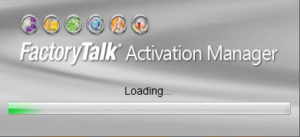 Copy Protection (aka Activation) is one of those topics that always seems to elicit a visceral response. It’s the old, “I paid for this software but the copy protection is preventing me from using it!” mantra.
Copy Protection (aka Activation) is one of those topics that always seems to elicit a visceral response. It’s the old, “I paid for this software but the copy protection is preventing me from using it!” mantra.
However, it’s widely accepted that without copy protection, software piracy would run wild. And while I’ve run into my own “copy protection” frustrations over the years, I’ve also witnessed piracy dozens (if not hundreds) of times in the industrial automation world.
So what is FactoryTalk Activation?
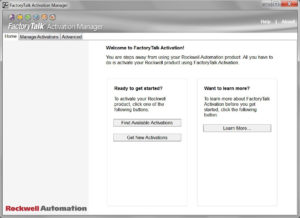 Enter FactoryTalk Activation (FTActivation) from Rockwell Automation. Simply put, it’s copy protection for Rockwell Automation’s modern software packages. FTActivation replaces the old Floppy Disk activation (EVRSI.sys) which was inherited from ICOM after they were purchased in the mid-nineties.
Enter FactoryTalk Activation (FTActivation) from Rockwell Automation. Simply put, it’s copy protection for Rockwell Automation’s modern software packages. FTActivation replaces the old Floppy Disk activation (EVRSI.sys) which was inherited from ICOM after they were purchased in the mid-nineties.
I often compare FactoryTalk Activation to Microsoft’s activation for Office or Windows. The big difference being Microsoft doesn’t tell you which hardware it’s activating to, while FactoryTalk activation actually makes you chose a unique piece of computer hardware (referred to as a “Host ID”) to activate the software to.
With FTActivation the three types of hardware you can activate to are:
- A PC Ethernet card (internal or removable) identified by it’s unique MAC ADDRESS
- A PC Harddrive (internal or external) identified by it’s unique SERIAL NUMBER
- A Rockwell USB Dongle (now also includes flash memory, PN# 9509-USBDONG2, $137) identified by it’s unique ID
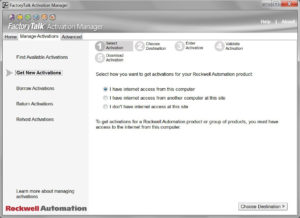 Note: I did not list a USB Flash Drive. They can’t be used as a “Host ID” since they don’t have unique serial numbers like hard drives.
Note: I did not list a USB Flash Drive. They can’t be used as a “Host ID” since they don’t have unique serial numbers like hard drives.
FTActivation is also like Microsoft Office or Windows in that it can be “Activated” either by using the internet (easiest) or by making a free phone call to the companies activation support line. However, with FTActivation you can also “Activate” your Rockwell software through their free online chat system, as well as through email and fax.
To activate your software, you’ll need a couple of pieces of information. First off, you’ll need your “product key” and “serial number” from the “Red Envelope” which came with your Rockwell software. If you’ve lost it fear not, just call or chat with Rockwell Activation Tech Support and they’ll send you a copy.
You’ll also need to know the unique “Host ID” of the computer you want to activate the software to. The FactoryTalk Activation Manager (formerly the FactoryTalk Activation Tool) which comes with Rockwell software that uses FTActivation has a wizard to help you find this, but if your handy with PC’s you’ll already know how to find your MAC ADDRESS or Hard Drive serial number.
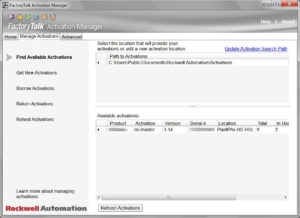 Note: Be careful when choosing an Ethernet card for activation. Some versions of Windows will disable your wired Ethernet card when it’s not connected, and some PC’s are setup to disable your Wireless Ethernet card when you connect to a wired network. And if your Ethernet card is your “Host ID” but it’s not enabled, your software won’t activate and run. So if your PC is setup that way you may wish to chose your hard drive serial number, an external device, or the Rockwell activation dongle as your FTActivation “Host ID.”
Note: Be careful when choosing an Ethernet card for activation. Some versions of Windows will disable your wired Ethernet card when it’s not connected, and some PC’s are setup to disable your Wireless Ethernet card when you connect to a wired network. And if your Ethernet card is your “Host ID” but it’s not enabled, your software won’t activate and run. So if your PC is setup that way you may wish to chose your hard drive serial number, an external device, or the Rockwell activation dongle as your FTActivation “Host ID.”
Once you’ve rounded up the required information and have chosen a “Host ID,” you can run through the FactoryTalk Acitvation “get activations” wizard to get activations for you PC. And if at any time your confused or frustrated don’t hesitate to call or chat with Rockwell’s free activation support team – I’ve called them dozens of times from client sites and they always quickly and efficiently help clients through the activation process.
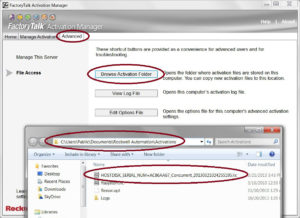 Once you’ve completed the activation process you will receive an “.LIC” text file which needs to reside in the folder the FactoryTalk Manager software is currently set to monitor. With the Text file in the right place and your “Host ID” present and enabled, the FactoryTalk Activation Manager activates your software and you’re ready to go.
Once you’ve completed the activation process you will receive an “.LIC” text file which needs to reside in the folder the FactoryTalk Manager software is currently set to monitor. With the Text file in the right place and your “Host ID” present and enabled, the FactoryTalk Activation Manager activates your software and you’re ready to go.
In the case that you’ve activated your software to an external device (like a USB to Ethernet converter’s MAC ADDRESS, an external hard drive’s SERIAL NUMER, or the Rockwell Activation Dongle) you can copy your “.LIC” file to every PC you’ve installed the software on. Then when you plug your external device into one of your PC’s the FTActivation Manager on that PC will find it, compare it with the information in the “.LIC” file, and if they match it will activate your software for as long as that device is plugged in.
Well, I hope the above information on what FactoryTalk Activation is was helpful. If you have any comments or questions please feel free to use the “post a comment or question” link below.
Until next time, Peace ✌️
If you enjoyed this content, please give it a Like, and consider Sharing a link to it as that is the best way for us to grow our audience, which in turn allows us to produce more content 🙂
Shawn M Tierney
Technology Enthusiast & Content Creator
Support our work and gain access to hundreds members only articles and videos by becoming a member at The Automation Blog or on YouTube. You’ll also find all of my affordable PLC, HMI, and SCADA courses at TheAutomationSchool.com.
- FactoryTalk Design Workbench First Look, CCW Comparison - December 19, 2025
- Drew Allen of Grace Technologies on Automation, Safety, and More (P256) - December 17, 2025
- Robotics in Warehouse Automation with Erik Nieves of Plus One Robotics (P255) - December 10, 2025

Discover more from The Automation Blog
Subscribe to get the latest posts sent to your email.






I am trying to use FTAM on Win 8.1 as a client to a server in my office. A VM on my machine can see the activations available on the server; yet my host OS cannot. I hit refresh and nothing is ever visible in the activations list. If I am unable to reach the server, I get a notice about that. In this case, I get no messages about anything, just no activations. Tech Support couldn’t figure it out either.
Perhaps you know of some software that conflicts with FTAM? I turned off firewall, antivirus, reinstalled, all with no luck. It worked last year, but not this year.
Fixed it: I removed the old .lic files and refreshed the server’s activation list until all of the triangles went away, and then it worked.
Thanks for sharing your solution Phil!
Glad you got it working 🙂
Shawn Tierney
[sc name="stsigcom"]
I have a problem
Can you help me?
Eduardo,
Feel free to post your problem and if I know the answer I will share it with you,
Shawn Tierney
[sc name="stsigcom"]